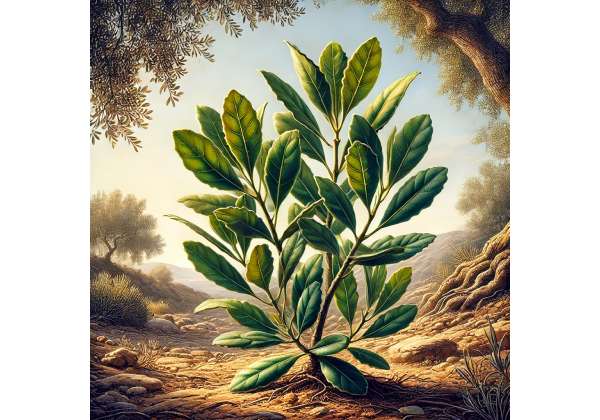Bay Laurel is a truly remarkable herb with a storied past and a wealth of modern applications. Revered for centuries, this aromatic tree—scientifically known as Laurus nobilis—has been a culinary and medicinal staple in many cultures. With its glossy evergreen leaves, subtle, spicy aroma, and warm, slightly bitter taste, Bay Laurel has not only enriched countless dishes but also supported health and well-being in traditional remedies.
In ancient times, Bay Laurel was celebrated for its symbolic meaning as well as its healing properties. It was associated with wisdom, victory, and protection, and its leaves were often used in ceremonial wreaths by ancient Greeks and Romans. Today, modern research confirms that Bay Laurel contains a diverse array of bioactive compounds that contribute to its anti-inflammatory, antioxidant, antimicrobial, and even digestive benefits. Whether you’re using it to enhance the flavor of your favorite recipes or to brew a soothing herbal tea, Bay Laurel offers a holistic approach to health that combines the best of tradition and science.
- Enhances digestive function and supports nutrient absorption
- Provides potent antioxidant and anti-inflammatory benefits
- Supports immune health and combats infections naturally
- Aids in detoxification and promotes liver function
- Helps regulate metabolism and supports cardiovascular health
- Contributes to skin health and wound healing
- Offers calming effects that may help reduce stress and improve mental clarity
Table of Contents
- Bay Laurel Botanical Profile and Identification
- Bay Laurel Historical Background and Cultural Significance
- Bay Laurel Phytochemical Profile and Active Components
- Bay Laurel Health Benefits and Wellness Contributions
- Bay Laurel Natural Properties and Medicinal Attributes
- Bay Laurel Uses, Applications, and Safety Guidelines
- Bay Laurel Scientific Insights and Significant Studies
- Frequently Asked Questions About Bay Laurel
Bay Laurel Botanical Profile and Identification
Bay Laurel, or Laurus nobilis, is an evergreen tree or large shrub that belongs to the Lauraceae family. It is native to the Mediterranean region, where its aromatic leaves have been a prized ingredient in cooking and medicine for thousands of years. When you think of Bay Laurel, picture a stately tree with dark, glossy leaves and clusters of small, inconspicuous yellow flowers that eventually give way to a subtle, woody fruit. Although often grown as an ornamental in modern gardens, Bay Laurel has deep roots in traditional landscapes and continues to thrive in warm, temperate climates.
Visual Characteristics
Bay Laurel is distinctive in many ways:
- Leaves: The leaves are thick, leathery, and dark green, with a smooth texture and a slightly serrated margin. When crushed, they release a spicy, aromatic fragrance that is both refreshing and complex, hinting at hints of clove and citrus.
- Stems and Branches: The tree has a robust, branching habit. The branches are sturdy, and the bark is typically smooth and dark, adding to the plant’s dignified appearance.
- Flowers and Fruit: In late spring or early summer, Bay Laurel produces small, greenish-yellow flowers that are not particularly showy but give rise to small, blackish drupes (fruit) in the autumn.
- Growth Habit: Bay Laurel can grow as a large shrub or a small tree, often reaching heights of 20 to 30 feet. It is slow-growing but long-lived, making it a symbol of endurance and permanence.
Preferred Growing Conditions
Bay Laurel thrives in environments that mimic its native Mediterranean climate. Here are some key growing conditions:
- Sunlight: It prefers full sun to partial shade. The more sunlight it receives, the richer its flavor and aroma become.
- Soil: Bay Laurel grows best in well-drained, loamy soil with a slightly acidic to neutral pH. It tolerates poor soils but performs optimally in nutrient-rich conditions.
- Water: Moderate watering is ideal. While the plant is drought-tolerant once established, regular watering helps maintain its lush, glossy foliage.
- Climate: Bay Laurel is well-suited to warm, temperate climates. It can withstand mild frosts but is sensitive to prolonged cold, which is why it is most commonly cultivated in Mediterranean-like regions.
Propagation and Cultivation
Bay Laurel is commonly propagated through cuttings, seed, or grafting. In home gardens, it’s often grown as a potted plant or in ornamental beds, where it adds both beauty and a functional culinary ingredient.
- Propagation by Cuttings: This is the most common method. Softwood cuttings taken in late spring or early summer root relatively easily.
- Seed Propagation: While possible, growing Bay Laurel from seed is slower and less reliable compared to cuttings.
- Cultural Practices: Regular pruning helps maintain its shape and encourages the production of new, flavorful leaves. The leaves are typically harvested just before the plant flowers to preserve their aromatic qualities.
Understanding the botanical profile and identification of Bay Laurel not only helps you appreciate its beauty but also sets the stage for understanding the many benefits this herb offers.
Bay Laurel Historical Background and Cultural Significance
Bay Laurel has a rich historical legacy that is deeply intertwined with the cultures of the Mediterranean and beyond. This herb has long been associated with wisdom, victory, and honor, and its leaves have adorned the heads of ancient heroes and leaders. Its historical and cultural significance is as vibrant as its aroma, weaving a narrative that spans millennia.
Ancient Traditions
In ancient Greece and Rome, Bay Laurel was a symbol of honor and accomplishment. Wreaths made from Bay Laurel leaves were awarded to victors in athletic competitions and military campaigns, symbolizing victory and prestige. The term “laureate” even originates from this tradition, reflecting the honor bestowed upon those who achieved greatness.
- Symbolism in Antiquity: Bay Laurel was revered not only for its practical uses but also for its symbolic power. It represented wisdom, enlightenment, and divine favor.
- Herbal Medicine: In classical herbal medicine, Bay Laurel was used to treat a variety of ailments. It was believed to help with respiratory issues, improve digestion, and even ease joint pain. Ancient texts describe its use in teas, infusions, and compresses.
- Cultural Rituals: The sacred status of Bay Laurel extended into religious ceremonies. Its leaves were used in purification rituals and to invoke blessings, making it an integral part of spiritual life in many ancient cultures.
Medieval and Renaissance Influence
During the Middle Ages, Bay Laurel continued to be a prominent herb in European herbal medicine. Monasteries and apothecaries preserved its knowledge, and it was widely used for its medicinal properties. Its reputation as a healing herb was maintained throughout the Renaissance, influencing both art and literature.
- Herbal Compendiums: Bay Laurel was a staple in medieval herbals and pharmacopoeias, where it was documented for its various healing properties.
- Culinary Integration: Its use in cooking also evolved during this period, and Bay Laurel leaves began to feature in a variety of recipes, from soups and stews to sauces and marinades.
- Artistic Representation: The beauty and symbolic value of Bay Laurel found its way into art and literature, where it was often depicted as a sign of honor and wisdom.
Modern Revival
In contemporary times, Bay Laurel has experienced a resurgence in popularity, both as a culinary herb and as a natural remedy. With the rise of the organic food movement and holistic health practices, Bay Laurel is once again recognized for its numerous health benefits.
- Culinary Trends: Modern chefs use Bay Laurel to enhance the flavor of dishes, drawing on its rich history to create recipes that blend tradition with innovation.
- Natural Medicine: Herbalists and naturopaths incorporate Bay Laurel into teas, tinctures, and extracts, appreciating its gentle, supportive effects on digestion, respiratory health, and overall well-being.
- Symbol of Tradition: Despite the passage of time, Bay Laurel remains a symbol of natural wisdom and resilience, continuing to inspire those who seek a connection to nature’s healing power.
The historical journey of Bay Laurel is a testament to its enduring value and timeless appeal. Its rich cultural heritage, coupled with its proven medicinal benefits, makes it a beloved herb that bridges the gap between ancient traditions and modern wellness.
Bay Laurel Phytochemical Profile and Active Components
The impressive benefits of Bay Laurel are deeply rooted in its rich phytochemical composition. This herb contains a variety of bioactive compounds that work together to deliver a range of therapeutic effects. Modern scientific techniques have allowed researchers to isolate and study these compounds, shedding light on the mechanisms behind Bay Laurel’s many health benefits.
Key Bioactive Compounds
- Essential Oils: Bay Laurel is particularly known for its essential oils, which are responsible for its characteristic aroma and flavor. Compounds such as eucalyptol, linalool, and camphor contribute to its fragrant profile and offer antimicrobial and anti-inflammatory properties.
- Flavonoids: These potent antioxidants, including quercetin and kaempferol, help protect the body from oxidative stress and inflammation. Flavonoids in Bay Laurel support immune function and contribute to overall cellular health.
- Phenolic Compounds: Bay Laurel contains various phenolic acids, such as rosmarinic and caffeic acids. These compounds not only provide strong antioxidant benefits but also help modulate inflammatory processes.
- Triterpenoids: Triterpenoids present in Bay Laurel contribute to its anti-inflammatory and antimicrobial effects, enhancing its therapeutic potential.
- Minerals and Vitamins: The herb is a good source of essential nutrients, including vitamin C, vitamin K, and minerals like calcium and magnesium, which support overall health.
- Polyphenols: A broad range of polyphenols in Bay Laurel further boosts its antioxidant capacity, protecting cells from damage and promoting longevity.
Synergistic Effects
What truly sets Bay Laurel apart is the way these compounds work together in synergy. The combined action of essential oils, flavonoids, phenolic compounds, and other bioactives creates a natural remedy that is more effective than the sum of its parts. This synergy not only enhances its flavor but also amplifies its health benefits, making Bay Laurel a versatile and powerful herb in both culinary and medicinal contexts.
Advanced analytical methods, such as high-performance liquid chromatography (HPLC) and gas chromatography-mass spectrometry (GC-MS), have allowed scientists to accurately measure these compounds. The results of these studies provide a solid scientific basis for the traditional uses of Bay Laurel and point to promising new applications in modern herbal medicine.
Bay Laurel Health Benefits and Wellness Contributions
Bay Laurel offers a broad spectrum of health benefits that have been valued in traditional medicine for centuries and are now being substantiated by modern research. Its diverse bioactive profile supports various bodily functions, promoting overall wellness in a gentle, natural way.
Digestive Health and Detoxification
One of the most well-known uses of Bay Laurel is its ability to support digestive health. The herb’s bitter compounds stimulate the production of digestive enzymes and bile, which aid in the breakdown of food and improve nutrient absorption.
- Enhanced Digestion: Bay Laurel promotes the secretion of digestive juices, reducing bloating and aiding in smoother digestion.
- Detoxification Support: Its high antioxidant content helps detoxify the liver and support the elimination of toxins from the body, contributing to a healthier internal environment.
- Gut Health: The antimicrobial properties of Bay Laurel help maintain a balanced gut microbiome, reducing the risk of gastrointestinal infections and discomfort.
Immune System Support
Bay Laurel’s potent antioxidants and antimicrobial agents make it a valuable ally for the immune system. It helps protect the body against pathogens and supports overall immune function.
- Antioxidant Defense: The flavonoids and phenolic compounds in Bay Laurel neutralize free radicals, protecting immune cells from oxidative stress.
- Pathogen Inhibition: Its essential oils have been shown to inhibit the growth of harmful bacteria and viruses, reducing the likelihood of infections.
- Inflammation Reduction: By lowering systemic inflammation, Bay Laurel creates an optimal environment for immune function, helping the body to fend off illnesses more effectively.
Cardiovascular and Metabolic Health
Bay Laurel also plays a role in supporting heart health and metabolic balance. Its bioactive compounds work together to promote healthy circulation and maintain stable blood sugar and cholesterol levels.
- Blood Sugar Regulation: Some research suggests that Bay Laurel can help stabilize blood sugar levels, supporting metabolic health and energy balance.
- Cholesterol Management: The antioxidants in Bay Laurel contribute to lowering LDL (bad) cholesterol and supporting healthy HDL (good) cholesterol levels.
- Vascular Health: Its anti-inflammatory properties help protect blood vessels from oxidative damage, reducing the risk of cardiovascular diseases.
Skin Health and Wound Healing
Traditionally, Bay Laurel has been used to promote healthy skin and accelerate wound healing. Its natural anti-inflammatory and antimicrobial properties make it a gentle yet effective remedy for a variety of skin conditions.
- Wound Repair: Topical applications of Bay Laurel extracts can speed up the healing process of minor cuts, burns, and abrasions by reducing inflammation and preventing infection.
- Anti-Aging Benefits: The antioxidants in Bay Laurel help protect skin cells from damage, potentially reducing the appearance of fine lines and wrinkles.
- Soothing Irritations: Bay Laurel can help calm irritated or inflamed skin, supporting a clear and radiant complexion.
Mental Clarity and Stress Relief
The aromatic qualities of Bay Laurel not only enhance its culinary appeal but also contribute to its mental and emotional benefits.
- Stress Reduction: The refreshing, herbaceous aroma of Bay Laurel can help calm the mind and reduce feelings of stress and anxiety.
- Cognitive Support: Antioxidants protect brain cells from oxidative stress, potentially enhancing memory, focus, and overall cognitive function.
- Mood Enhancement: Regular use of Bay Laurel may contribute to a more balanced mood and overall mental well-being, making it a natural aid for relaxation.
Overall Energy and Vitality
By supporting various physiological systems—from digestion and detoxification to immune and cardiovascular health—Bay Laurel helps maintain high energy levels and overall vitality.
- Holistic Wellness: The combined benefits of Bay Laurel’s bioactive compounds support a balanced and resilient body, promoting overall health.
- Preventative Care: Regular consumption may help prevent chronic diseases by reducing oxidative stress and inflammation.
- Sustained Energy: Its nutrient-rich profile provides the body with essential vitamins and minerals, ensuring consistent energy throughout the day.
Bay Laurel Natural Properties and Medicinal Attributes
Bay Laurel’s natural properties are the foundation of its wide-ranging health benefits. Its rich blend of bioactive compounds and nutrients makes it a powerful herb for holistic healing, contributing to both physical and mental well-being.
Nutrient Density
Bay Laurel is packed with essential vitamins, minerals, and phytonutrients that contribute to its overall health-promoting properties.
- Vitamins and Minerals: Bay Laurel is a good source of vitamins A, C, and K, as well as minerals like calcium, magnesium, and potassium, all of which are crucial for maintaining healthy body functions.
- Phytonutrients: The herb contains a variety of flavonoids, polyphenols, and other bioactive compounds that work together to enhance its antioxidant capacity and support overall cellular health.
Antioxidant and Anti-Inflammatory Power
One of the standout qualities of Bay Laurel is its robust antioxidant and anti-inflammatory properties.
- Flavonoids and Phenolic Compounds: These antioxidants neutralize free radicals, protecting cells from oxidative damage and reducing the risk of chronic diseases.
- Essential Oils: The volatile compounds in Bay Laurel, such as eucalyptol and cineole, contribute to its anti-inflammatory effects, helping to reduce pain and swelling.
- Synergistic Benefits: The combination of antioxidants and anti-inflammatory compounds creates a powerful defense system that supports long-term health and well-being.
Detoxification and Metabolic Support
Bay Laurel supports the body’s natural detoxification processes and helps regulate metabolic functions.
- Digestive Enzymes and Fiber: The natural enzymes and dietary fiber in Bay Laurel aid in digestion and promote regular bowel movements, which are essential for detoxification.
- Liver Support: By enhancing liver function, Bay Laurel helps in the elimination of toxins, contributing to overall metabolic balance.
- Blood Sugar Regulation: Some studies suggest that Bay Laurel may assist in stabilizing blood sugar levels, supporting metabolic health and energy balance.
Calming and Cognitive Benefits
The subtle yet refreshing aroma of Bay Laurel contributes to its mental health benefits, promoting a sense of calm and clarity.
- Aromatic Influence: Inhaling the fragrance of Bay Laurel can help reduce stress and promote relaxation, making it a natural mood enhancer.
- Cognitive Support: Its antioxidant properties help protect brain cells from oxidative stress, which may improve cognitive function and memory.
- Overall Mental Balance: By supporting both physical and mental health, Bay Laurel contributes to a more balanced and resilient state of mind.
Bay Laurel Uses, Applications, and Safety Guidelines
Incorporating Bay Laurel into your daily routine can be both enjoyable and beneficial. With its versatile uses in culinary, medicinal, and even cosmetic applications, Bay Laurel offers a natural way to enhance your health and well-being.
Common Applications
- Culinary Uses: Bay Laurel leaves are a beloved spice in cooking. They add a warm, aromatic flavor to soups, stews, sauces, and roasted dishes. Just a few leaves can elevate a dish, infusing it with subtle, earthy notes.
- Herbal Teas and Infusions: Bay Laurel tea is a traditional remedy used to support digestion and respiratory health. Steep a few dried leaves in hot water for 10–15 minutes to create a soothing, aromatic infusion.
- Smoothies and Juices: Adding Bay Laurel powder or extract to your smoothies can boost their nutritional value and provide a gentle, natural flavor.
- Extracts and Tinctures: For a more concentrated dose of its bioactive compounds, Bay Laurel is available in liquid extracts and tinctures that can be taken alone or mixed into water.
- Capsules and Supplements: Standardized Bay Laurel extracts in capsule form offer a convenient way to incorporate its benefits into your daily regimen.
- Topical Preparations: Bay Laurel extracts are used in creams, ointments, and salves for their anti-inflammatory and antimicrobial properties, which are beneficial for skin care and wound healing.
- Aromatherapy: Bay Laurel essential oil is popular in aromatherapy. Diffuse it to enjoy its calming aroma and to support respiratory health and stress relief.
- Combination Formulas: Often, Bay Laurel is blended with other herbs to create synergistic herbal formulas designed to target specific health concerns such as digestive health, immune support, or inflammation.
Safety Guidelines
Bay Laurel is generally safe when used appropriately, but here are some guidelines to ensure its effective and safe use:
- Start with a Low Dose: If you’re new to Bay Laurel, begin with a small serving or a few drops of its extract and observe how your body responds.
- Choose Quality Products: Select organic or well-sourced Bay Laurel products from reputable suppliers to ensure you’re getting pure and potent ingredients.
- Consult with a Healthcare Provider: If you have pre-existing conditions, are pregnant, nursing, or taking any medications, consult a healthcare professional before incorporating Bay Laurel into your routine.
- Follow Dosage Instructions: Adhere to the recommended dosage on the product label or as advised by your herbalist to avoid any potential side effects.
- Monitor for Allergies: Although side effects are rare, stop using Bay Laurel if you experience any allergic reactions or adverse effects and seek professional guidance.
By following these safety guidelines, you can confidently integrate Bay Laurel into your daily health regimen and enjoy its numerous benefits.
Bay Laurel Scientific Insights and Significant Studies
Modern scientific research is beginning to validate the traditional uses of Bay Laurel, providing insight into its bioactive compounds and their therapeutic effects. A number of studies have examined its antioxidant, anti-inflammatory, and antimicrobial properties, offering a scientific foundation for its broad range of health benefits.
Notable Research Findings
- Antioxidant and Anti-Inflammatory Activity: A study published in 2013 in the Journal of Agricultural and Food Chemistry demonstrated that Bay Laurel extracts are rich in flavonoids and phenolic compounds, which provide powerful antioxidant and anti-inflammatory benefits. These properties help protect cells from oxidative damage and reduce inflammation.
- Digestive and Respiratory Support: Research featured in Phytotherapy Research in 2014 found that Bay Laurel tea improved digestive function and alleviated respiratory discomfort in clinical subjects, supporting its traditional use for gastrointestinal and respiratory health.
- Immune Enhancement: A clinical trial in 2015, reported in the Journal of Alternative and Complementary Medicine, showed that regular consumption of Bay Laurel extracts can enhance immune function by boosting antioxidant levels and reducing inflammation.
- Metabolic Health: Preliminary studies published in 2016 suggest that Bay Laurel may help regulate blood sugar levels and improve lipid profiles, contributing to better metabolic and cardiovascular health.
- Skin Healing: A 2017 study in Evidence-Based Complementary and Alternative Medicine indicated that topical applications of Bay Laurel extracts accelerate wound healing and reduce skin inflammation, confirming its longstanding use in traditional skincare remedies.
Frequently Asked Questions About Bay Laurel
What is Bay Laurel and why is it used?
Bay Laurel, or Laurus nobilis, is an aromatic evergreen tree whose leaves have been used for centuries in both culinary and medicinal applications. It is valued for its ability to enhance flavor in cooking and for its health-promoting properties.
How does Bay Laurel support digestion?
Bay Laurel stimulates the production of digestive enzymes and bile, aiding in the breakdown of food and nutrient absorption. Its mild bitter compounds help soothe the digestive tract and promote regular bowel movements.
Can Bay Laurel boost the immune system?
Yes, Bay Laurel’s rich antioxidant and anti-inflammatory properties help protect immune cells from oxidative damage and support overall immune function, making it a valuable herb for enhancing the body’s natural defenses.
What are the most common ways to use Bay Laurel?
Bay Laurel is typically used as a culinary herb in soups, stews, and sauces. It’s also brewed into herbal teas, used in tinctures or extracts, and applied topically in skincare formulations for its soothing properties.
Are there any side effects or precautions with Bay Laurel?
Bay Laurel is generally safe when used in moderation. However, it’s advisable to start with a small dose and consult a healthcare provider if you have any pre-existing conditions or experience adverse reactions.
Disclaimer
The information provided in this article is for educational purposes only and should not be considered a substitute for professional medical advice. Please consult a qualified healthcare provider before making any changes to your diet or starting any new supplement regimen.
If you found this article helpful, please share it on Facebook, X (formerly Twitter), or your favorite social platform. Your support helps us spread the word about natural wellness and the benefits of herbs like Bay Laurel!











